If you've been looking for the best feta and olive sourdough recipe, this detailed guide will help you bake a stunning loaf with an open crumb and tangy bite. The combination of crumbly feta cheese, briny olives, and a beautifully fermented, tangy sourdough starter creates a loaf that’s flavorful, hearty, and perfect for sandwiches or to enjoy on its own.
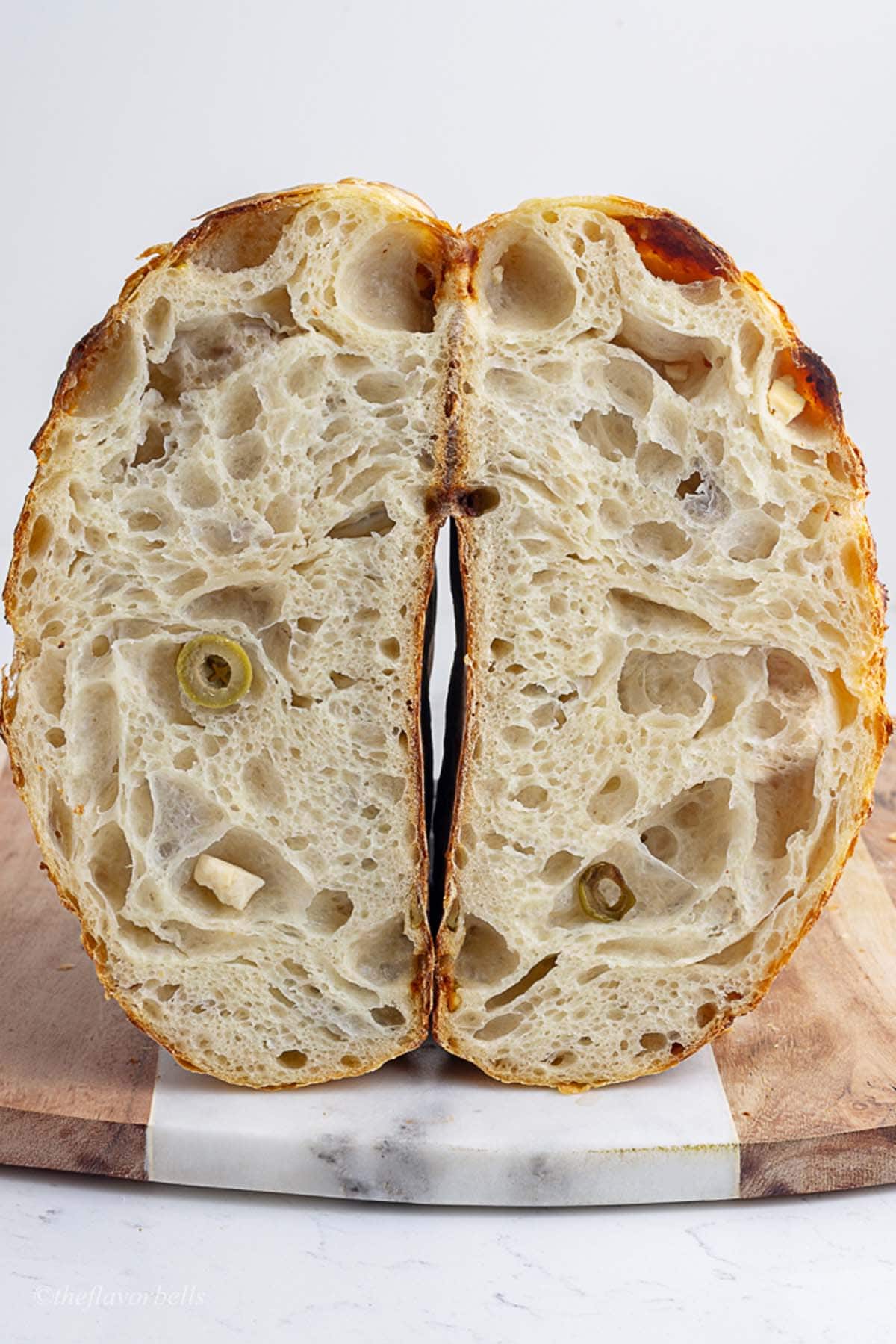
Jump to:
👩🏽🍳 Why You’ll Love This Feta Sourdough Bread ?
- Bursting with flavor: From the tangy feta cheese to the rich olives and subtle sourdough flavor, every bite is a flavor explosion.
- Versatile Usage: Enjoy it for breakfast, toast it for a sandwich, or serve it as an appetizer with olive oil and balsamic vinegar.
- Sourdough for every season: Whether you’re baking in a cozy fall kitchen or prepping for a summer picnic, this loaf suits all vibes.
- Customizable inclusions: Don’t like olives? Swap them for sun-dried tomatoes, caramelized onions, or even dill for a twist like in onion dill sourdough bread.
- Healthier Option: Naturally fermented sourdough bread recipes tend to be more digestible and flavorful than regular bread, making this an excellent choice for those who love wholesome, homemade breads.
🧂Ingredient Notes & Substitutes
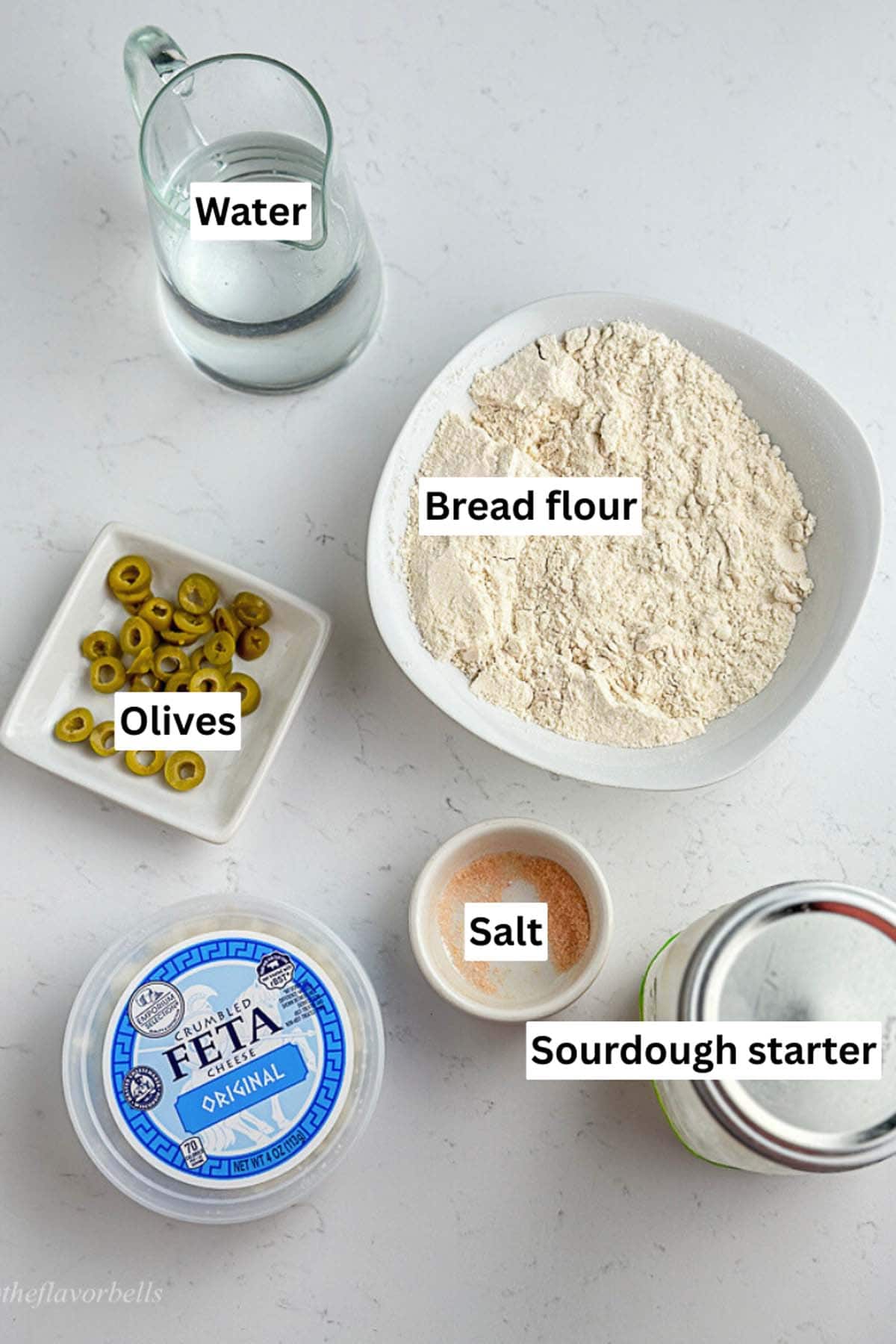
Understanding the ingredients is key to making the perfect olive and feta sourdough recipe. Below are some insights and replacement options:
- Bread Flour: Opt for high-protein bread flour to build a strong gluten network. Can be substituted with all-purpose flour, though it may result in a softer crust.
- Active Sourdough Starter: Ensure your sourdough starter is bubbly and active for the best fermentation. If you don't have a starter, you can create one following simple recipes online.
- Water: Use room-temperature water to properly hydrate the dough, which improves its structure and texture.
- Salt: Essential for flavor balance—don't skip it! You can experiment with sea salt or Himalayan salt for slight variations.
- Olives: Use black or green olives, ensuring they're pitted and roughly chopped to distribute evenly.
- Feta Cheese: Crumbled feta cheese brings the perfect salty tang. You can swap it with cheddar or goat cheese for a different take.
🔪 How to Make Feta Olive Sourdough Bread
1. Combine the Dough/hydrate the flour
Start by adding the bread flour and most of the water (set aside about 15g to mix with salt later) into a large mixing bowl. Use a dough whisk or the back of a large ladle to stir and begin combining. At this point, you're just hydrating the flour, not kneading.
Once you’ve brought most of the flour and water together, switch to wet hands. This prevents sticking and allows you to incorporate any dry flour patches more thoroughly. Scrape down the sides of the bowl as needed using a dough scraper or your hand. You want a rough, shaggy dough.
Cover the bowl with a clean towel or lid and let it rest for 45 minutes. This process is called the autolyse, and it jumpstarts gluten formation without salt interference.
2. Incorporate the Sourdough Starter

Once your flour and water have rested and the gluten has begun to form through autolyse, it's time to introduce the sourdough starter, the heart of every sourdough bread recipe. Add your active sourdough starter to the center of the hydrated dough. If your starter is ready, it should smell slightly tangy and look bubbly and airy.
Begin to disperse the starter throughout the dough. You’ll notice the dough becoming stickier and slightly looser. Switch to wet hands and use the pinch-and-fold method: pinch the dough between your fingers to break up clumps, then fold the outer edges into the center. Rotate the bowl as you go, working methodically until the starter is fully combined and the dough looks uniform and slightly elastic.
Scrape down the sides of the bowl with a dough scraper to gather everything neatly into a cohesive mass. Cover the bowl and let the dough rest at room temperature for 30 minutes. This short resting period allows the wild yeast in the starter to begin feeding and kickstart fermentation.
This step ensures the starter is well-distributed, which is essential for a proper rise and an even crumb structure in your final olive and feta sourdough loaf.
3. Add the Salt and Reserved Water
After your dough has rested with the sourdough starter, it’s time to add the salt—an essential step that strengthens the gluten network, enhances flavor, and helps control fermentation. The process is called bassinage.
In a small bowl, dissolve the measured salt in the reserved water. Stir until the salt is completely dissolved. This step ensures even distribution and makes it easier to mix into the dough without damaging its structure.
Pour the saltwater solution over the dough. Use wet hands to gently work the salt water into the dough. Begin by using a pinch-and-fold motion: pinch sections of the dough between your fingers and fold them over. Rotate the bowl and repeat until the liquid is mostly absorbed.
Then switch to gentle kneading or folding right inside the bowl. Avoid aggressive kneading—sourdough dough is best handled softly to preserve developing gluten and inclusions. As you continue mixing, the dough will begin to tighten and gain elasticity.
Post bassinage the dough feels more unified, cover the bowl and let it rest for 20–30 minutes before moving on to the stretch and folds.
4. Bulk Fermentation with Stretch and Folds
Cover the bowl with a damp towel and begin bulk fermentation at room temperature (around 75°F). Over the next 4–6 hours, perform 4 sets of stretches and folds every 30 minutes. This strengthens the dough without kneading.
5. Lamination: Add the Inclusions
Instead of folding the inclusions directly into the dough, we'll use a technique called lamination—a gentle method that allows for even distribution of feta cheese and olives without degassing the dough.
After completing the bulk, lightly dust the work surface with flour to prevent sticking. Carefully, turn the dough out onto the floured surface.
Now, stretch the dough into a thin, large rectangle—ideally about 2 to 3 times its original surface area. Be patient, and let the dough relax as needed. It should feel supple and elastic, not tight or tearing.
Then, evenly scatter the crumbled feta cheese and roughly chopped olives across the entire surface of the dough. If using optional additions like finely chopped sun-dried tomatoes or fresh herbs, sprinkle them in at this point.
Now fold the dough like a letter: fold one-third over the center, then fold the other third on top (like folding a business letter). This gently traps the inclusions inside. Finally, perform a book fold: rotate the dough 90 degrees, gently stretch it again, and fold it into thirds once more if it feels manageable. This step isn’t mandatory, but can help further distribute inclusions.
Flip the dough and let it rest uncovered on the counter for 10-15 minutes before final shaping.
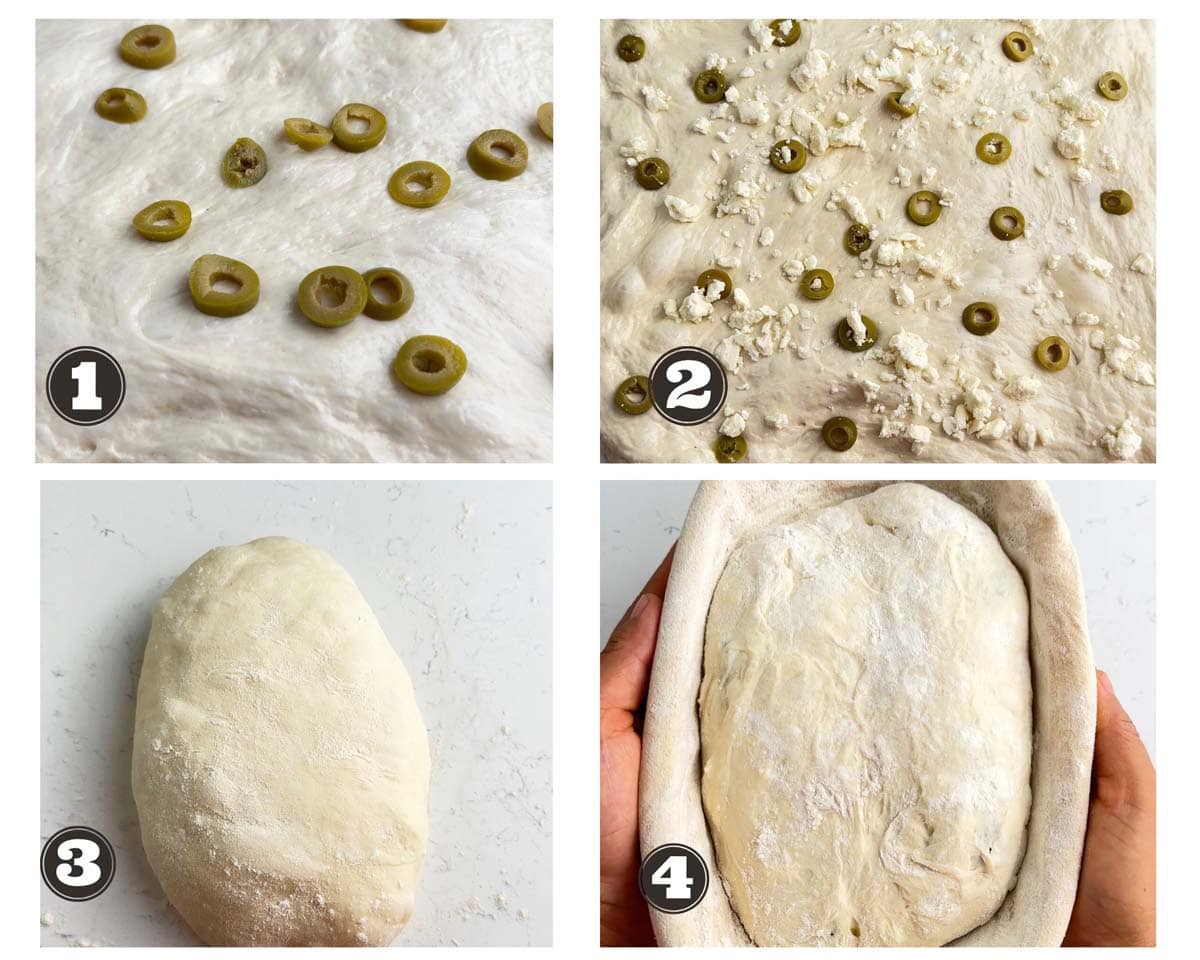
6. Shape the Dough
Lightly dust your countertop with flour, just enough to prevent sticking. Using a bench scraper, gently flip the dough over so the smooth side is down and the sticky side is up. Try not to deflate it; you want to keep the air bubbles intact.
Using your fingertips, lightly pat the dough into a rectangle. Starting from the long edges, fold each side of the dough about a third of the way toward the center, overlapping slightly. This begins building surface tension and narrows the loaf for the classic batard shape. Now starting from the top (the short edge furthest from you), roll the dough downward toward yourself, tucking as you go. Each roll should gently stretch the outer skin, building tension without bursting the dough.
When you reach the bottom edge, gently pinch the seam closed using your fingertips. Also, pinch and tuck the side ends to give the batard a neat, tight look.
7. Cold Proofing/ Cold retard
Carefully lift the shaped batard and place it into a floured banneton or a bowl lined with a well-floured kitchen towel with the seam facing up. Use rice flour or a blend of rice and bread flour to prevent sticking.
Cover and refrigerate for 8–12 hours. This cold retardation develops deeper flavors.
8. Preheat and Bake
Preheat your Dutch oven to 500°F (260°C) with the lid on. Turn out the dough onto a piece of parchment paper, score the top with a sharp blade, and carefully lower it into the hot pot.
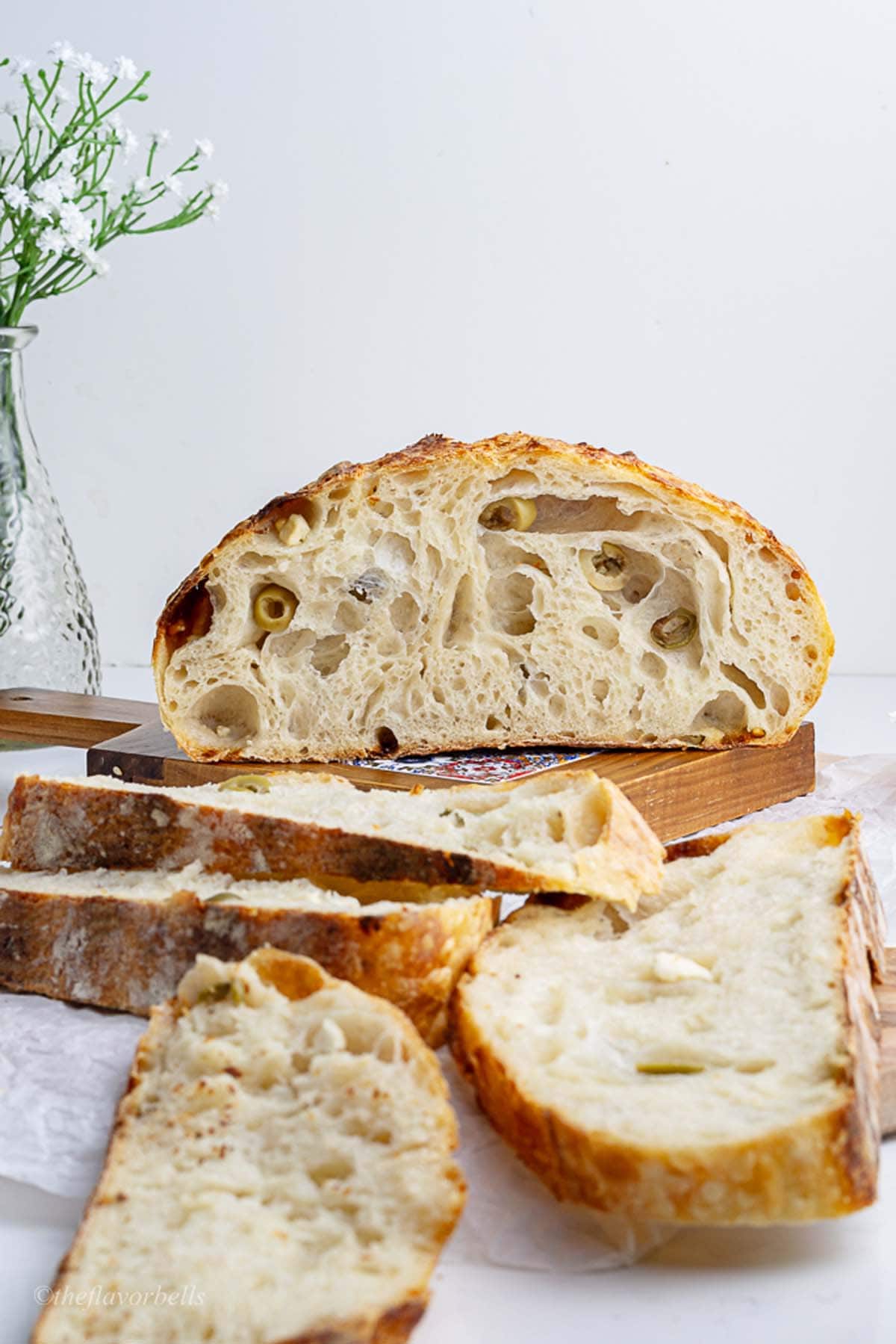
Bake covered for 20 minutes. Then reduce the temperature to 450° F (230° C) uncovered for another 20–22 minutes until deep golden.
Let the feta and olive sourdough loaf cool for at least 1 hour before slicing.
Recipe Tips & Notes
- Make sure all ingredients are at room temperature to avoid shocking the wild yeast.
- Use a kitchen scale for precise measurements—this makes all the difference in sourdough baking.
- Avoid overmixing once the inclusions are added; this helps maintain an open crumb.
- This recipe also works beautifully as a base for cheese sourdough bread, apple sourdough bread, and onion dill sourdough bread by swapping inclusion ingredients.
🔗More sourdough Inclusion recipes
- Cinnamon Sourdough
- Chocolate chip sourdough
- Pumpkin Sourdough
- Blueberry sourdough
- Cinnamon Raisin Sourdough
- Garlic sourdough
- Jalapeno Cheddar sourdough
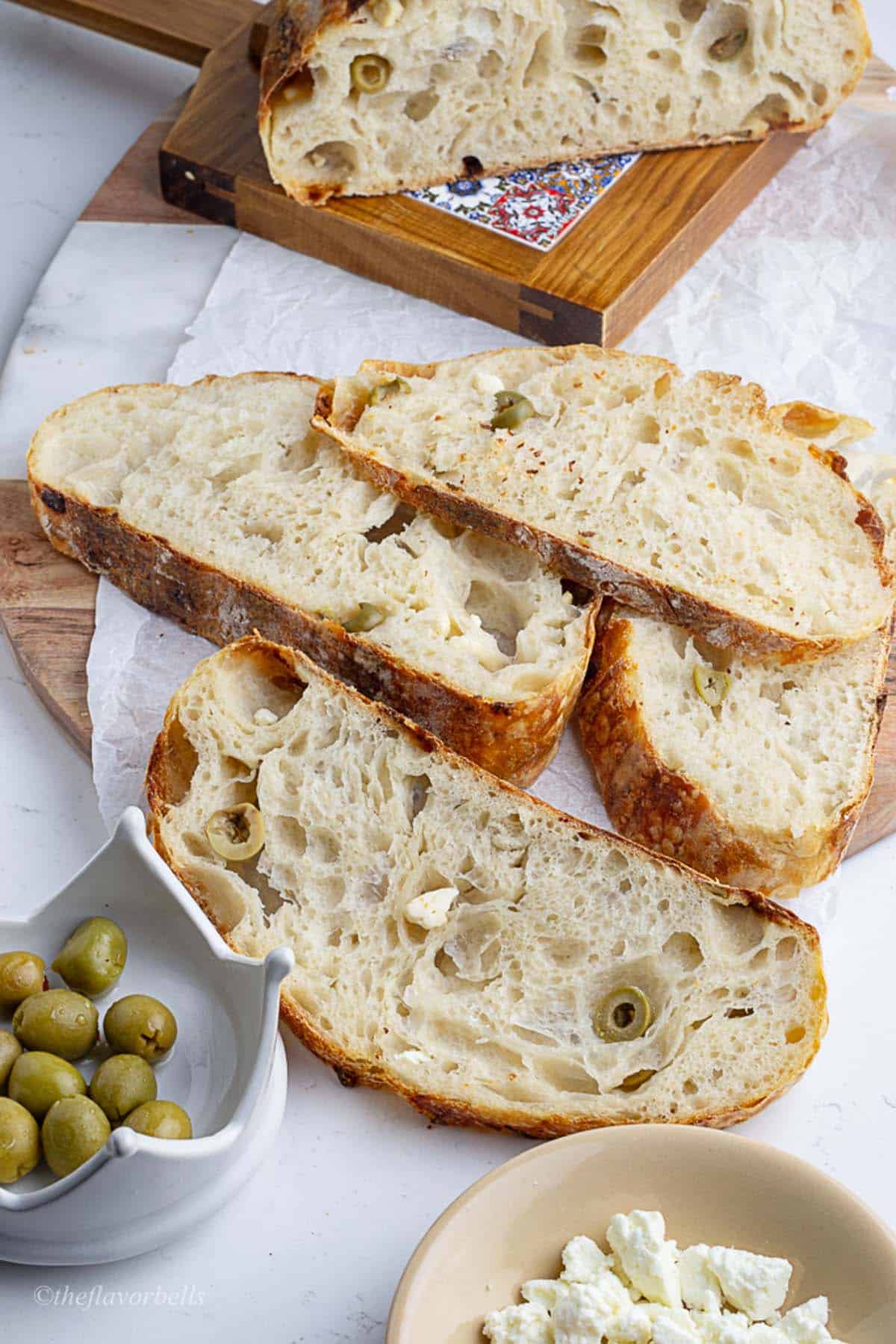
Whether you eat it warm with olive oil or slice it up for a feta sourdough sandwich, this loaf is full of love, flavor, and artisan charm. Don’t forget to leave a comment and let me know how yours turned out!
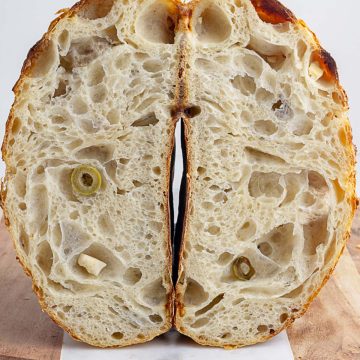
Feta and Olive Sourdough
Ingredients
Dough:
- 350 g Bread Flour (about 2 ¾ cups)
- 70 g Sourdough Starter (about ¼ cup)
- 235 g Water (about 1 cup, reserve 15g)
- 7 g Salt (about 1 ¼ tsp)
Inclusions:
- 50 g Olives (roughly chopped about ¼ cup)
- 50 g Feta Cheese (crumbled about ¼ cup)
Instructions
Hydrate the Flour (Autolyse)
- In a large bowl, mix bread flour with most of the water (save some to mix with salt later).
- Use a dough whisk or the back of a ladle to combine until a rough, shaggy dough forms.
- Switch to wet hands to ensure all dry patches are moistened, scraping down the sides of the bowl as needed.
- Cover and rest for 45 minutes—this is the autolyse, which helps gluten begin developing naturally.
Add the Sourdough Starter
- Add your active sourdough starter to the hydrated dough.
- With wet hands, use the pinch-and-fold method to mix it in—pinching sections and folding them over repeatedly until the dough looks uniform and slightly elastic.
- Scrape down the bowl, cover, and rest for 30 minutes to jumpstart fermentation.
Add Salt and Reserved Water (Bassinage)
- Dissolve salt in the reserved water and pour it over the dough.
- Mix using wet hands, incorporating gently with a pinch-and-fold motion followed by soft kneading inside the bowl.
- As the dough tightens and becomes smoother, you'll feel it gain structure. Cover and let rest again for 20–30 minutes.
Bulk Fermentation with Stretch & Folds
- Let the dough ferment at room temperature (around 75°F).
- Over 4–6 hours, perform 4 sets of stretches and folds, spaced 30 minutes apart.
- Each fold strengthens the dough without aggressive kneading.
- Cover between sets and let the dough rise slowly.
Lamination: Add Olives & Feta
- After bulk fermentation, turn the dough onto a lightly floured surface. Gently stretch it into a large, thin rectangle.
- Evenly scatter chopped olives and crumbled feta over the surface.
- Fold the dough like a letter, then rotate and fold once more (book fold) to lock inclusions inside.
- Rest the dough uncovered for 10–15 minutes.
Shape the Batard
- Lightly flour your surface. Flip the dough so the smooth side faces down.
- Pat gently into a rectangle, fold the long edges inward slightly overlapping, then roll it from the top down into a tight batard.
- Pinch the seam and sides to seal and build surface tension.
Cold Proof
- Place the shaped dough seam-side up into a well-floured banneton or lined bowl. Cover and refrigerate for 8–12 hours. This cold proofing (retardation) helps build flavor and structure.
Bake
- Preheat a Dutch oven at 500°F (260°C).
- Turn the dough out onto parchment paper, score the top, and transfer to the hot Dutch oven.
- Bake covered for 20 minutes.
- Then bake uncovered at 450°F (230°C) for another 20–22 minutes.
- Let the bread cool on a wire rack for at least 1 hour before slicing.
Notes
- Use a mature, active sourdough starter
For the best rise and flavor, your sourdough starter should be bubbly, airy, and pass the float test. If your starter isn't ready, your olive and feta sourdough recipe may turn out dense or under-proofed. - Always measure using a kitchen scale
Sourdough baking is sensitive to hydration levels. Use a digital kitchen scale for precise results, especially when working with additions like feta cheese, olives, or sun-dried tomatoes. - Room temperature ingredients are key
Ensure your water, sourdough starter, and flour are all at room temperature. Cold ingredients can slow down fermentation, while overly warm ingredients may accelerate it too fast. - Lamination helps ensure even inclusion distribution
Instead of mixing in feta and olives directly, laminate the dough after bulk fermentation. This gentle technique helps you spread inclusions without degassing the dough, ensuring even flavor and a beautiful open crumb. - Prevent sticking with parchment paper and rice flour
Always use parchment paper when baking in a Dutch oven, and dust your banneton with a mix of bread and rice flour to prevent the dough from sticking during cold proof. - Customize your inclusions
Try swapping feta with goat cheese or aged cheddar. You can also add finely chopped sun-dried tomatoes, roasted garlic, caramelized onions, or herbs like dill to create variations like onion dill sourdough bread or cheddar dill sourdough bread. - Olive types make a difference
Use pitted Kalamata or green olives for the best results. Roughly chop for even distribution. - Avoid overhandling after adding feta
Feta is a delicate cheese. Overmixing can crush it and make your dough overly wet or uneven. Gently fold it in during lamination for the best texture.
Nutrition
🫙🔥Storage & Reheating
- Store the completely cooled feta sourdough in a bread box or wrapped in a clean towel at room temperature for up to 3 days.
- For longer storage, freeze slices in a zip bag for up to 2 months.
- Reheat slices in the oven at 350°F for about 10 minutes or toast straight from the freezer.
❓Frequently Asked Questions
Sourdough bread is incredibly versatile when it comes to inclusions. Some of the best include feta cheese, sun-dried tomatoes, olives, caramelized onions, and herbs like dill or rosemary. When adding inclusions, it’s important to keep a few rules in mind: chop everything into small, even pieces, and blot off excess moisture to prevent gummy dough. Timing also matters—add inclusions after the first or second stretch and fold during bulk fermentation so you don’t disrupt the gluten too early. Creative combos like feta, sundried tomato, or cheddar dill sourdough bread can really elevate your loaf.
While this recipe relies on an active sourdough starter, you can adapt it by using commercial yeast. Replace the starter with 1 ½ teaspoons dry yeast, increase the bulk fermentation to 4 hours, and let the dough rise at room temperature.


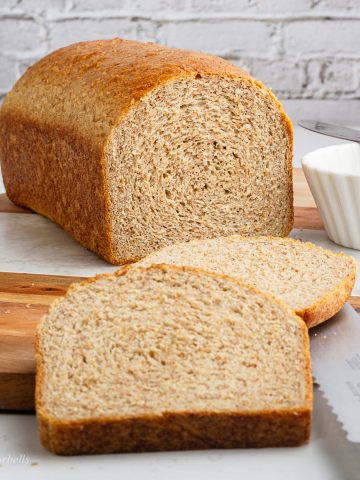
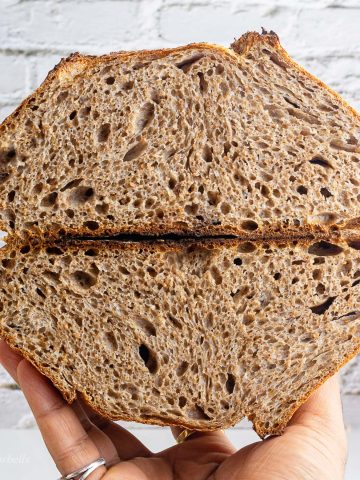


Leave a Reply